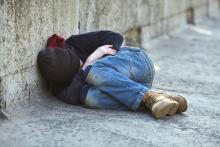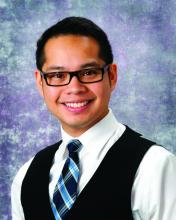As winter settles in for most of the United States, there are some people who do not have access to adequate shelter from the cold. Currently, there are an estimated 700,000 homeless youth in the United States, which is roughly 1 out of 30 youth.1 The reasons for these disparities are complex, although stigma and discrimination are major factors. Despite the major challenges faced by this population, medical providers can play a role in addressing homelessness among LGBT youth.
According to the Department of Education, homeless youth are defined as youth “who lack a fixed, regular, and adequate nighttime residence.”2 Although the image of a person sleeping on a bench at a park covered with newspapers comes to mind, it may not be obvious that a youth may be homeless. Sometimes, youth may be sleeping in their cars at night and others may be staying the night at one house and then staying the next night at another house (known as “couch surfing”). Many will be utilizing homeless shelters to sleep in.
Homelessness among LGBT youth is a major problem in the United States. Although LGB (sexual minority) people comprise 2%-7% of the population,3 about one-third of homeless youth identify as LGB or questioning. Additionally, about 4% of homeless youth identify as transgender, compared with 1% of the general youth population in the United States. LGBT youth are at a higher risk for homelessness than are cisgender (gender identity matches with the assigned sex at birth), heterosexual youth. There are even disparities within LGBT youth.
Why are LGBT youth at high risk for homelessness? The most common reason is family rejection of their sexual orientation and/or gender identity.4 Some are directly kicked out by their families. Whereas others leave because relationships with their families have become so strained after the child has come out that the environment is no longer tolerable to live in. However, poverty and race may play a significant role in this phenomenon. There is a misperception that families of color are more homophobic or transphobic (disliking or having a prejudice against transsexual or transgender people) than white families because there is a higher proportion of LGBT homeless youth of color. However, what most likely increases the likelihood of family rejection is the strain of poverty, which people of color are more likely to experience. Chronic unemployment or unstable housing makes it very difficult for families to utilize the important skills to accept and support their LGBT child. Whenever a child comes out to their parents, it is a stressful event for the family. Family with stable physical resources (decent income, stable housing) also are more likely to have psychological resources (family cohesiveness, open communication, good parent-child relationships) to manage these types of stress. However, for those with unstable resources, they are unable to tap into their psychological resources to handle the stress of a child coming out to them.5 As a result, they resort to rejection. Many parents believe that rejecting their child’s sexual orientation or gender identity will protect them from stigma and discrimination, and they do not realize that rejection can harm their child.6,7
There are other reasons LGBT youth become homeless. One is untreated mental illness and substance use, mostly likely a result from experiencing stigma and discrimination. Another is that some age out of the foster care system.4 Finally, some LGBT youth run away from home because of abuse from their parents, and unfortunately, LGBT youth are more likely to experience abuse from a parent than are heterosexual, cisgender youth.8
Furthermore, although there are homeless shelters for youth, many LGBT youth avoid going to homeless shelters out of fear for their own safety. Many homeless shelters are ill equipped to work with LGBT youth, especially in managing other homeless youth who may harass or assault another youth on the basis of their sexual orientation or gender identity.4 Additionally, many homeless shelters arrangements are gendered, making it difficult for transgender youth to find a shelter as they may be forced to live with people of their assigned sex of birth, putting them at an increased risk for harassment and violence.9
Despite the many challenges faced by homeless LGBT youth, medical providers can play a role in promoting their health and well-being. Screening for homelessness can create opportunities for medical providers to offer resources for immediate needs. Three good questions are: “During the last 12 months, was there a time when you were not able to pay the mortgage or rent on time?” “In the past 12 months, how many places [have you] lived?” and “What type of housing do you currently live in?”10 Resources for such youth would include the National Coalition for the Homeless, which contains a list of homeless shelters that are equipped to address the needs of LGBT homeless youth.
Medical providers must address some of the root causes of homelessness among LGBT youth. One of them is family rejection. Medical providers can counsel parents of LGBT youth in the importance of family support in protecting their LGBT child from adverse health outcomes. One good resource is the Family Acceptance Project, which teaches parents skills to support their LGBT child. Additionally, medical providers can work with homeless shelters and help them develop best practices for working with LGBT youth. A good place to start is Lambda Legal’s National Recommended Best Practices for Serving LGBT Homeless Youth.
Educating both families and homeless shelters are key in both preventing homelessness and mitigating the effects of homelessness on the health of LGBT youth.
Dr. Montano is assistant professor of pediatrics at the University of Pittsburgh and an adolescent medicine physician at Children’s Hospital of Pittsburgh of UPMC. Email him at pdnews@mdedge.com.
References
1. “Missed opportunities: Youth homelessness in America,” Chapin Hall at the University of Chicago, 2017. voicesofyouthcount.org.
2. Homelessness & Runaway Youth. Federal Definitions. youth.gov.
3. MMWR Surveill Summ. 2016. doi: 10.15585/mmwr.ss6509a1.
4. “Serving Our Youth 2015: The Needs and Experiences of Lesbian, Gay, Bisexual, Transgender and Questioning Youth Experiencing Homelesness,” The Williams Institute with True Colors Fund, June 2015.
5. Sex Roles. 2013 Jun;68(11-12):690-702.
6. “Supportive families, healthy children: Helping families with lesbian, gay, bisexual & transgender children,” Family Acceptance Project, San Francisco State University, 2009.
7. Pediatrics. 2009 Jan. doi: 10.1542/peds.2007-3524.
8. Am J Public Health. 2011. doi: 10.2105/AJPH.2009.190009.


